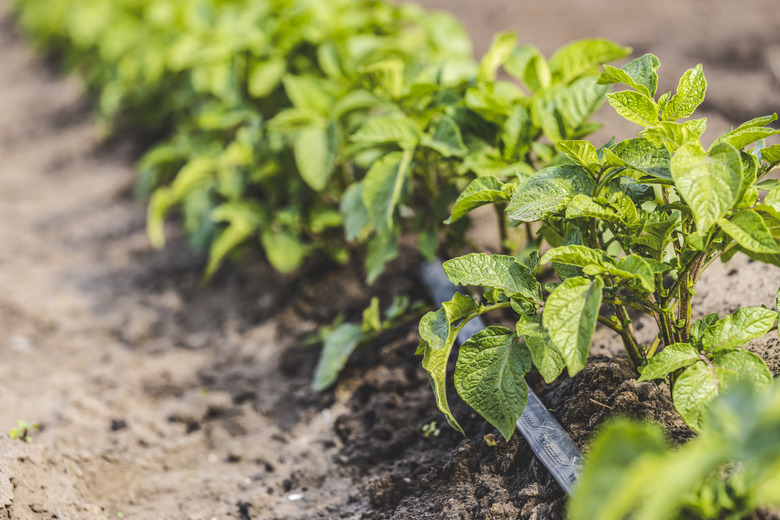Natural Bug Spray For Potato Plants
We may receive a commission on purchases made from links.
The potato (Solanum tuberosum) is both a much-loved staple and one of the easiest garden plants to grow. Unfortunately, like tomatoes, eggplants, peppers and even tobacco — their cousins in the nightshade family — potatoes are also loved by a variety of insect pests. It's not hard to find a commercial pesticide to save your spuds, but you can also DIY a natural bug spray for potato plants using lower-impact ingredients if you'd prefer.
Common Potato Pests
Common Potato Pests
Most of the insects in your garden do no harm, and some are actively beneficial, but a few can seriously damage your crop. With potatoes, the leading culprit is the Colorado potato beetle, often referred to as "potato bugs." They're a small and rather pretty beetle dressed in orange and black stripes, and their larvae are dark red or orange with two rows of black dots running down their bodies. Both have a huge appetite for potato leaves and can strip your plants bare.
Potato leafhoppers are pale green and feed on the underside of the leaves, so they're harder to spot until your potatoes develop a signature triangular brown spot near the ends of their leaves. Aphids are another common problem, and one that's less specific to potatoes. As with the many other plants they attack, aphids suck the juices from your plants' stems, leaving them weakened, less productive and more susceptible to disease.
Other insect pests may attack your potatoes as well, but these three are the most common and widespread.
Neem Oil Spray
Neem Oil Spray
Neem oil is one of the most widely useful natural insecticides. It's pressed from seeds of the tropical neem tree (Azadirachta indica, USDA zones 10-12), and it's effective against Colorado potato beetles, leafhoppers, aphids and many other pests. It's usually sold in the form of a concentrated oil and must be diluted with an appropriate amount of water — usually to a concentration of 1 to 2 percent — before use. The ratio varies by brand, so always follow the package directions.
Neem oil is dangerous to beneficial pollinators, so it's usually best to spray in the evening when they're less active. Be sure to get both the tops and bottoms of the leaves (leafhoppers prefer the underside) as well as the stems, where aphids congregate. Neem oil won't kill the adult insects, but it's lethal to nymphs and larvae. You'll need to reapply the oil to quell any future hatchlings, but after a few applications, you'll have disrupted their life cycle pretty thoroughly.
Spinosad-Based Spray
Spinosad-Based Spray
Spinosad is a natural insecticide derived from a soil bacterium, Saccharopolyspora spinosa. It's notable for low toxicity to humans and wildlife, though it's dangerous to bees while it's wet. Like neem oil, you'll want to apply it when pollinators aren't active. It won't kill insects on contact like harsher pesticides, but they'll stop eating immediately and will die soon. It works on potato beetles and leafhoppers but isn't effective for aphids.
Like neem oil, it's typically sold in concentrated form if you want to make your own, so you'll need to dilute it according to the manufacturer's instructions. In the case of Bonide's Dead Bug Brew Concentrate, one popular spinosad product, the ratio is 2 fluid ounces (4 tablespoons) per gallon of water.
Insecticidal Soap Spray
Insecticidal Soap Spray
Soaps have a well-demonstrated ability to kill insects and larvae, especially the soft-bodied ones. Commercial insecticidal soaps are specially formulated for that purpose, and they're available in ready-to-use formulations in spray bottles. Insecticidal soap works well on aphids and some other pests but not leafhoppers or potato beetles, so you might wish to combine your soap mixture with neem oil or spinosad for a multipurpose spray.
Tips and Alternative Controls
Tips and Alternative Controls
Mixing up a batch of a natural insecticide is only one part of the main goal, which is to have a pest-free potato patch with minimal impact on the environment. These tips and alternative controls can help get you the rest of the way:
- Always use a clean sprayer. If it has previously been used for a herbicide or another pesticide, the results can be unpredictable or even dangerous.
- Test your spray on a small scale before you use it widely. Spray one plant or a part of one plant and watch for adverse effects. This is especially important if your plants are already stressed from drought or other causes.
- Physical controls can work well for small infestations. Pick off potato beetles and their larvae or leafhoppers and their nymphs and drown them in a small container filled with soapy water.
- Aphids can be removed in large numbers by hosing them from the plants with a strong stream of water. If you're watering your potatoes anyway, this is an easy way to double the benefit.
- Learn to identify common beneficial/predatory insects in your garden. If you see lots of them, there's an excellent chance that your pest problem is taking care of itself naturally. More to the point, spraying indiscriminately can suppress populations of these natural predators, which means you may actually be making your problem worse.
- Introduce predators, such as ladybug beetles or parasitic wasps, at the first sign of pests.
- Use netting to cover your plants, reducing the beetles' ability to infiltrate your potato patch.
